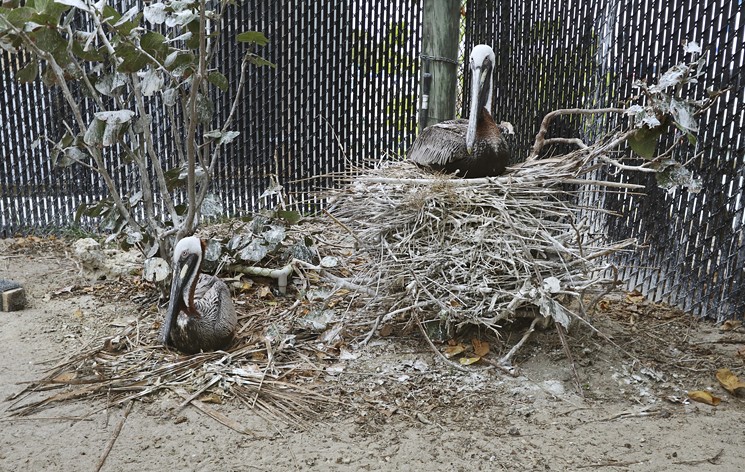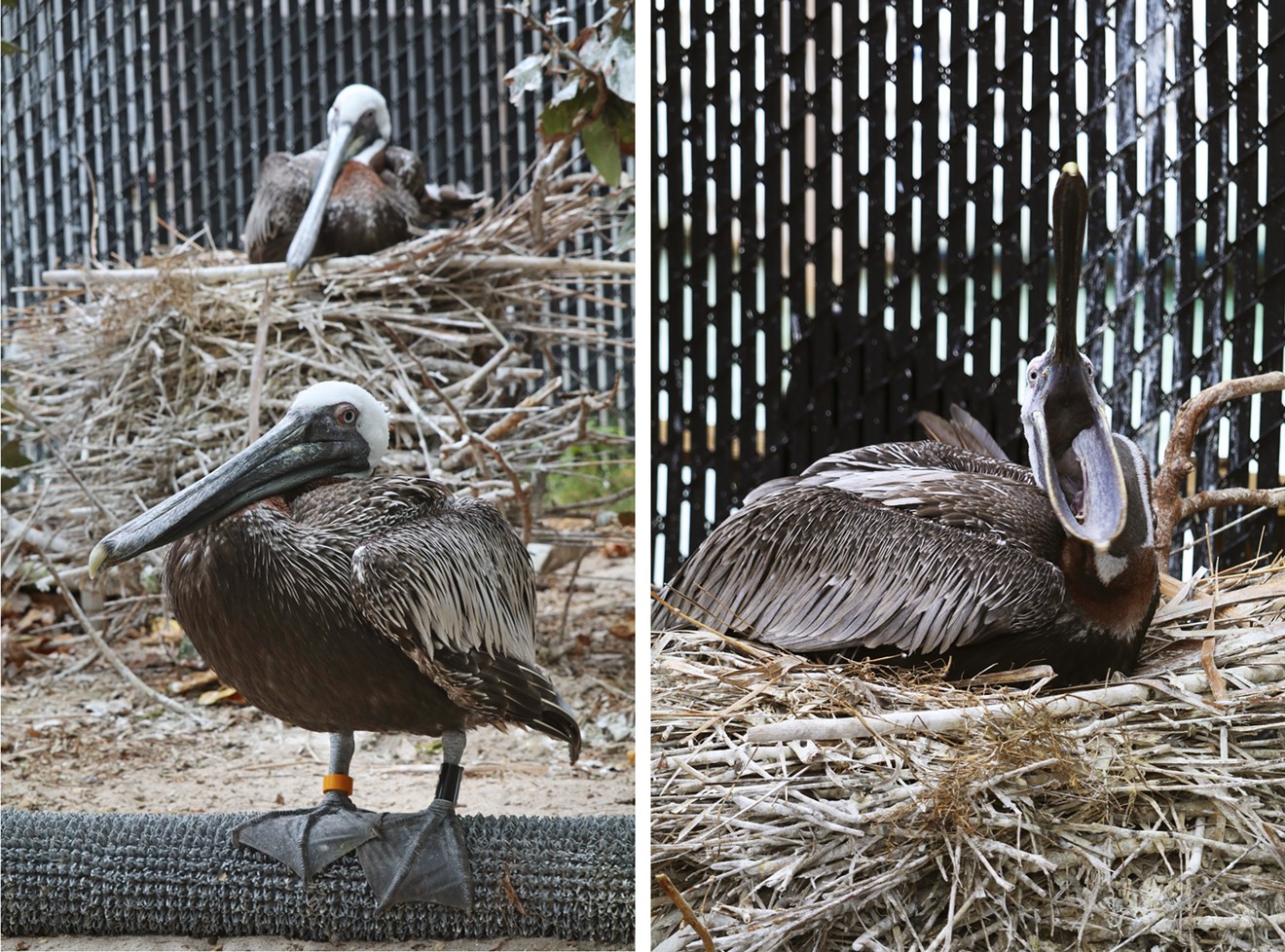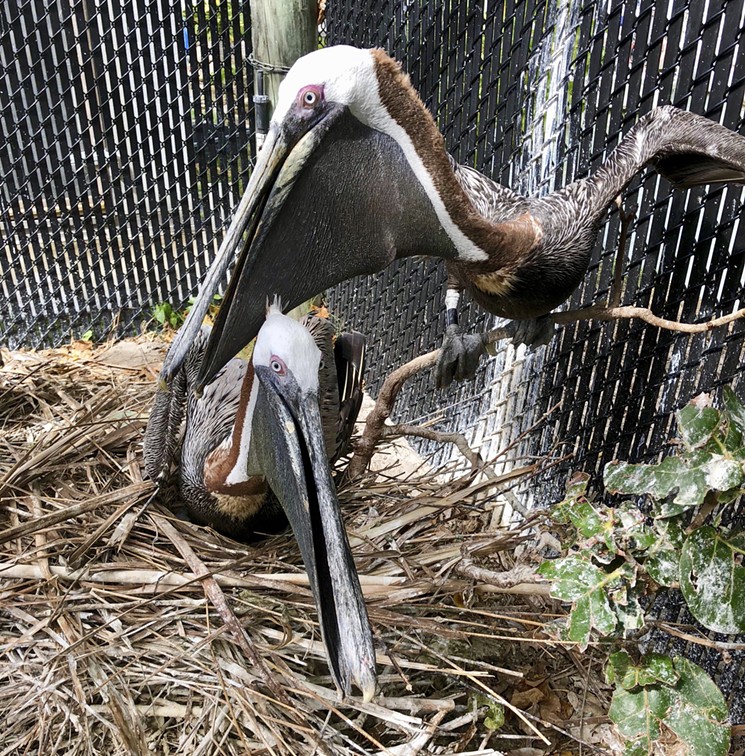At Pelican Harbor Seabird Station, a wildlife rehabilitation center in North Bay Village, two birds of a feather do a lot more than just flock together.
Pepe and Enrique, both American brown pelicans from South Florida, have spent nearly two decades as a devoted same-sex couple. At the beginning of breeding season this past December, "the boys" — as their caretakers refer to them — built a nest together in the corner of the large pen where they live overlooking Biscayne Bay.
Normally, a male pelican seeking a mate performs a courtship dance and offers a stick to a female. If she accepts, the pair collaborates to build a nest, defend it, and raise their young. Pelican nests are typically less than a foot tall.
Pepe and Enrique's nest, meanwhile, stands more than two feet tall. It's not the first one they've built, but definitely the largest. The couple takes turns: One sits in it, while the other perches on a branch a few inches away. Sometimes they sit in it side-by-side.
The two arrived separately at the Seabird Station in the early 2000s. Pepe was brought in with an "angel wing" — a deformation caused by a nutritional deficiency. Enrique arrived with a "frozen wing" — an injury caused by a fishing line or hook. Unable to fly and fish, they would've starved to death in the wild.
The boys perform courtship dances and frequently consummate their relationship.
tweet this
Seabird Station, the boys' sanctuary, began in 1980 when local engineer Harry Kelton and his wife Darlene moved their houseboat to the Pelican Harbor Marina and saw a brown pelican with a fishhook in his mouth. They had zero experience in animal rehab, but the couple nursed him back to health. Since then, Seabird Station has become an internationally renowned rescue organization, with eight staff members and more than 40 volunteers who have treated nearly 10,000 pelicans and countless other creatures.
But the nonprofit's mission is to rescue, rehab, and release animals — not house them long-term. With just three-tenths of an acre of land, Seabird Station has limited space. Moreover, the U.S. Fish And Wildlife Service mandates that rescue organizations euthanize animals that can't sustain themselves. Debilitated animals can be kept only as "ambassadors" for educational purposes.
Pepe and Enrique are two of the lucky ones. Space opened up in Seabird Station's Permanent Pelican Pen when they arrived. The two not only became fast friends but also ambassadors.
Aside from nest-building together, the boys perform courtship dances for each other and, according to staff members, "frequently" consummate their relationship.
Because male pelicans don't have phalluses, they achieve union by performing a cloacal kiss. In layman's terms: One mounts the other, they bring their cloacae (small posterior orifices) together, and do a kind of birdie lambada, rubbing until climax. The process is the same for opposite-sex pelicans.
How to explain Pepe and Enrique's behavior? Are they just lonely jailbirds seeking comfort in the absence of female company?
Not exactly. Eight other pelicans share their pen. Five are sexually mature females. The lads just aren't particularly interested in those birds.
Sure, there was a time, about two summers ago, when the boys were seen engaging "in a bit of copulation" with a female, says Seabird Station's executive director, Christopher Boykin. "But they weren't pairing up and building a nest with her. When it comes to nesting season, they're always together. It's always just them — always has been for more than 15 years. Even during non-nesting season, they're usually together in the corner."
Boykin, a biologist with extensive experience in animal research and rehabilitation, is the former communications director for the Florida Department of Environmental Protection Coral Reef Conservation Program. Prior to that, he worked for the Biscayne Bay Aquatic Preserves, another state agency. He came to Seabird Station in 2014 to fulfill a dream of running a seabird hospital.

In the animal and bird world, seasonal monogamy is common, Boykin explains. But Pepe and Enrique display a rare lifelong monogamy. He estimates they're about 20 years old but says he and his staff are combing through 30,000 patient intake records. "Pepe and Enrique's data is buried in there with the other patients, so we're going through the old files to digitize them. Then we'll have a better idea."
Seabird Station biologist and rehabilitation manager Yaritza Acosta says the boys "pretty much stick to themselves. Since there aren't many options [in their pen], you usually see the same pelicans hooking up."
Yet limited options don't explain why Pepe and Enrique shun the available females when it comes time to build a nest and breed.
Some theories posit that homosexual activity in the animal kingdom is simply a dominance issue, akin to same-sex dogs mounting one another to assert their alpha status. But that's not the case here, according to Acosta: "That's a big-mammal thing. I guess for some birds, there's kind of a dominance issue sometimes, but I haven't seen anything like that with our pelicans."
Not only are none of Seabird Station's pelicans vying to be the baddest bird on the block, but also Pepe and Enrique's behavior doesn't even seem to ruffle their pen mates' feathers — probably because same-sex unions in the wild are fairly common.
What's behind all of this free love in the wild?
tweet this
Three years ago, Seabird Station transferred a same-sex female pelican couple to the San Antonio Zoo. Two male flamingoes have been paired up since the '90s, and even raised a chick together, at Zoo Atlanta. Two male vultures at an Amsterdam zoo recently did the same. Roy and Silo, male penguins at the Central Park Zoo in Manhattan, also raised a chick and inspired an award-winning children's book — And Tango Makes Three — about their relationship.
Aptly named bighorn sheep, meanwhile, have all-male orgies. So do giraffes, bottlenose dolphins, killer whales, gray whales, and West Indian manatees, according to Popular Science. Female unions are also rampant in the wild. And bonobos, humans' closest living relatives, are notoriously bisexual.
In 1999, Canadian biologist Bruce Bagemihl wrote the definitive text on same-sex animal relationships. In his 768-page tome, Biological Exuberance: Animal Homosexuality and Natural Diversity, he documented same-sex behavior in 191 species (the list has since been updated to 1,500 species) and explained that homosexuality refers to any of four behaviors between members of the same sex: long-term bonding, sexual contact, courtship displays, and the rearing of young.
Pepe and Enrique display all four, according to Boykin. He says former Seabird Station executive director Wendy Fox, who died in 2011, gave Pepe and Enrique several eggs, which they cared for until the chicks hatched. "With Wendy gone, we can't be sure how many times they did that," he says, "but we're going to try again when we have an opportunity."
Ron Magill, Zoo Miami's communications director and wildlife expert, says he's seen several long-term same-sex animal couples, including a pair of local lesbian flamingos: "They courted each other, mounted, and produced eggs that were, of course, infertile. We would then substitute the infertile eggs with fertile ones from a heterosexual pair and the lesbian pair brooded, hatched, and raised the young successfully."
So what's behind all of this free love in the wild?
Some theories suggest that same-gender sex is a bonding mechanism and a way to solve conflicts among social animals. Theories about "a gay gene," meanwhile, though pervasive in popular culture, remain scientifically inconclusive. And a 2006 study of frequent girl-on-girl activity among Japanese macaques had a very simple conclusion: The monkeys do it because it feels good. Ultimately, research shows that a certain percentage of animals within some species will always choose a partner of the same sex regardless of social circumstances.
It's unclear which factors motivate Pepe and Enrique. Zoo Miami's Magill says that they "may simply be homosexual" but that other factors could play a role — such as their being non-flighted permanent residents under human care. "The variables make it hard to come to a definitive conclusion," he says.
How, though, do the traits responsible for same-sex attraction in an animal persist in a population when that animal is less likely to reproduce and pass on those traits?
According to a study of fruit flies published in the journal Proceedings of the Royal Society B, the female offspring of males who engage in same-sex behavior tend to have higher fertility rates. In other words, being related to homosexual males could actually provide an evolutionary advantage. The exact causes, though, are still unclear.
It suffices to say the birds and the bees are more complex than previously thought.
Meanwhile, at Seabird Station, Pepe and Enrique will soon pick apart their giant nest and scatter the sticks. Next winter, breeding season will begin anew and the girls in the Permanent Pelican Pen will try once again to find a mate.
When it comes to Pepe and Enrique, though, it appears that bird has flown.














